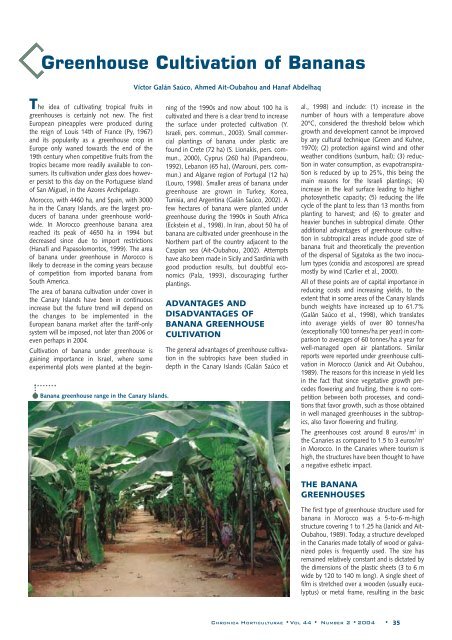Number 2 - 2004 - Acta Horticulturae
Number 2 - 2004 - Acta Horticulturae
Number 2 - 2004 - Acta Horticulturae
You also want an ePaper? Increase the reach of your titles
YUMPU automatically turns print PDFs into web optimized ePapers that Google loves.
Greenhouse Cultivation of Bananas<br />
Víctor Galán Saúco, Ahmed Ait-Oubahou and Hanaf Abdelhaq<br />
The idea of cultivating tropical fruits in<br />
greenhouses is certainly not new. The first<br />
European pineapples were produced during<br />
the reign of Louis 14th of France (Py, 1967)<br />
and its popularity as a greenhouse crop in<br />
Europe only waned towards the end of the<br />
19th century when competitive fruits from the<br />
tropics became more readily available to consumers.<br />
Its cultivation under glass does however<br />
persist to this day on the Portuguese island<br />
of San Miguel, in the Azores Archipelago.<br />
Morocco, with 4460 ha, and Spain, with 3000<br />
ha in the Canary Islands, are the largest producers<br />
of banana under greenhouse worldwide.<br />
In Morocco greenhouse banana area<br />
reached its peak of 4650 ha in 1994 but<br />
decreased since due to import restrictions<br />
(Hanafi and Papasolomontos, 1999). The area<br />
of banana under greenhouse in Morocco is<br />
likely to decrease in the coming years because<br />
of competition from imported banana from<br />
South America.<br />
The area of banana cultivation under cover in<br />
the Canary Islands have been in continuous<br />
increase but the future trend will depend on<br />
the changes to be implemented in the<br />
European banana market after the tariff-only<br />
system will be imposed, not later than 2006 or<br />
even perhaps in <strong>2004</strong>.<br />
Cultivation of banana under greenhouse is<br />
gaining importance in Israel, where some<br />
experimental plots were planted at the begin-<br />
Banana greenhouse range in the Canary Islands.<br />
ning of the 1990s and now about 100 ha is<br />
cultivated and there is a clear trend to increase<br />
the surface under protected cultivation (Y.<br />
Israeli, pers. commun., 2003). Small commercial<br />
plantings of banana under plastic are<br />
found in Crete (72 ha) (S. Lionakis, pers. commun.,<br />
2000), Cyprus (260 ha) (Papandreou,<br />
1992), Lebanon (65 ha), (Marouni, pers. commun.)<br />
and Algarve region of Portugal (12 ha)<br />
(Louro, 1998). Smaller areas of banana under<br />
greenhouse are grown in Turkey, Korea,<br />
Tunisia, and Argentina (Galán Saúco, 2002). A<br />
few hectares of banana were planted under<br />
greenhouse during the 1990s in South Africa<br />
(Eckstein et al., 1998). In Iran, about 50 ha of<br />
banana are cultivated under greenhouse in the<br />
Northern part of the country adjacent to the<br />
Caspian sea (Ait-Oubahou, 2002). Attempts<br />
have also been made in Sicily and Sardinia with<br />
good production results, but doubtful economics<br />
(Pala, 1993), discouraging further<br />
plantings.<br />
ADVANTAGES AND<br />
DISADVANTAGES OF<br />
BANANA GREENHOUSE<br />
CULTIVATION<br />
The general advantages of greenhouse cultivation<br />
in the subtropics have been studied in<br />
depth in the Canary Islands (Galán Saúco et<br />
al., 1998) and include: (1) increase in the<br />
number of hours with a temperature above<br />
20°C, considered the threshold below which<br />
growth and development cannot be improved<br />
by any cultural technique (Green and Kuhne,<br />
1970); (2) protection against wind and other<br />
weather conditions (sunburn, hail); (3) reduction<br />
in water consumption, as evapotranspiration<br />
is reduced by up to 25%, this being the<br />
main reasons for the Israeli plantings; (4)<br />
increase in the leaf surface leading to higher<br />
photosynthetic capacity; (5) reducing the life<br />
cycle of the plant to less than 13 months from<br />
planting to harvest; and (6) to greater and<br />
heavier bunches in subtropical climate. Other<br />
additional advantages of greenhouse cultivation<br />
in subtropical areas include good size of<br />
banana fruit and theoretically the prevention<br />
of the dispersal of Sigatoka as the two inoculum<br />
types (conidia and ascospores) are spread<br />
mostly by wind (Carlier et al., 2000).<br />
All of these points are of capital importance in<br />
reducing costs and increasing yields, to the<br />
extent that in some areas of the Canary Islands<br />
bunch weights have increased up to 61.7%<br />
(Galán Saúco et al., 1998), which translates<br />
into average yields of over 80 tonnes/ha<br />
(exceptionally 100 tonnes/ha per year) in comparison<br />
to averages of 60 tonnes/ha a year for<br />
well-managed open air plantations. Similar<br />
reports were reported under greenhouse cultivation<br />
in Morocco (Janick and Ait Oubahou,<br />
1989). The reasons for this increase in yield lies<br />
in the fact that since vegetative growth precedes<br />
flowering and fruiting, there is no competition<br />
between both processes, and conditions<br />
that favor growth, such as those obtained<br />
in well managed greenhouses in the subtropics,<br />
also favor flowering and fruiting.<br />
The greenhouses cost around 8 euros/m 2 in<br />
the Canaries as compared to 1.5 to 3 euros/m 2<br />
in Morocco. In the Canaries where tourism is<br />
high, the structures have been thought to have<br />
a negative esthetic impact.<br />
THE BANANA<br />
GREENHOUSES<br />
The first type of greenhouse structure used for<br />
banana in Morocco was a 5-to-6-m-high<br />
structure covering 1 to 1.25 ha (Janick and Ait-<br />
Oubahou, 1989). Today, a structure developed<br />
in the Canaries made totally of wood or galvanized<br />
poles is frequently used. The size has<br />
remained relatively constant and is dictated by<br />
the dimensions of the plastic sheets (3 to 6 m<br />
wide by 120 to 140 m long). A single sheet of<br />
film is stretched over a wooden (usually eucalyptus)<br />
or metal frame, resulting in the basic<br />
CHRONICA HORTICULTURAE •VOL 44 • NUMBER 2 • <strong>2004</strong> • 35
















